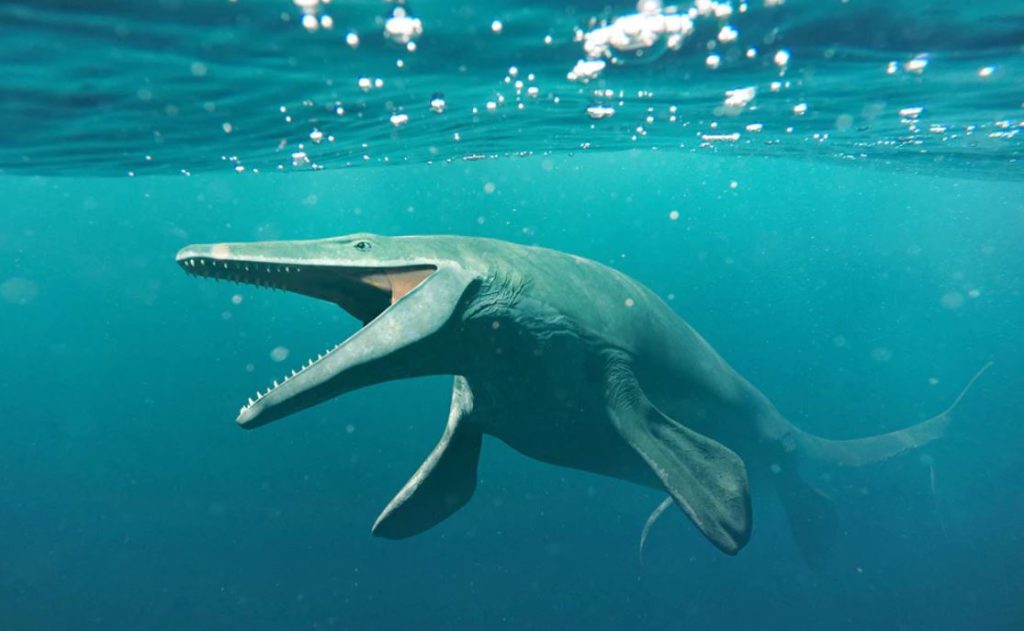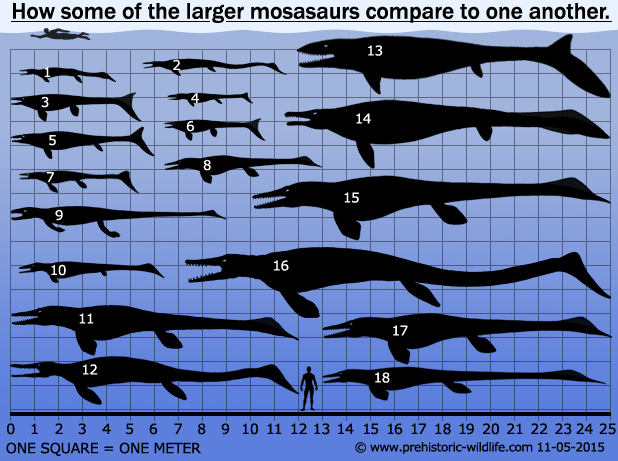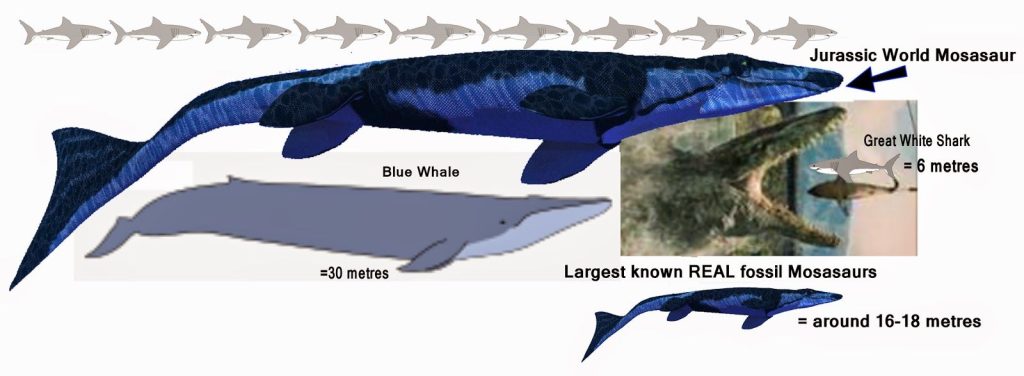Fascinating Facts and Images of Mosasaurus. Unearth the formidable mosasaur from the Late Cretaceous, renowned for its role in the movie Jurassic World…
What Is a Mosasaurus?
Mosasaurus, an extinct marine reptile, dwelled during the final stages of the Cretaceous Period, approximately 66 to 82.7 million years ago. It is important to note that Mosasaurus is not a dinosaur; instead, it shares ancestry with land-dwelling lizards, belonging to the reptilian order Squamata, which encompasses lizards and snakes.
Mosasaurus is not a single species but a genus, denoting a group of closely related animals. Various Mosasaurus species have been identified, including M. hoffmannii, M. lemonnieri, and M. missouriensis.
For further understanding of terms like “genus” and “species,” you can refer to this page: Animal Classification.
Mosasaurs
Mosasaurus is among the well-known mosasaurs, a group of aquatic lizards that reigned as dominant marine predators during the end of the Cretaceous Period. Mosasaurus is just one of approximately 40 known genera or types of mosasaurs.
Unlike its four flippers, it was the narrow and deep tail of a mosasaur that propelled it through the water. Steering was accomplished using the four flippers. Similar to present-day whales and dolphins, mosasaurs had to emerge at the water’s surface to breathe.
Large eyes in mosasaurs imply keen eyesight, suggesting they hunted primarily using their sense of vision.
Due to its size and adaptations for aquatic life, Mosasaurus is believed to have been entirely marine, born in the sea and spending its entire life there.
Based on the fossils of other mosasaurs, it is speculated that Mosasaurus gave birth to live young, unlike sea turtles that lay eggs on the shore.
Impressions of scales, similar to those of Plotosaurus, have been discovered in other mosasaur fossils, indicating that mosasaurs had scaly skin.

What Does Mosasaurus Mean?
The term “Mosasaurus” translates to “lizard of the Meuse River.” One of the earliest-known Mosasaurus fossils was found in a limestone quarry near Maastricht, a city located along the Meuse River in the Netherlands.
Was Mosasaurus a Dinosaur?
Mosasaurus should not be confused with dinosaurs. It is neither related to nor descended from the other large marine reptiles of the Mesozoic Era, such as ichthyosaurs and plesiosaurs. Instead, Mosasaurus and other mosasaurs evolved from land-dwelling lizards and gradually adapted to an aquatic lifestyle.
Hence, Mosasaurus (along with all mosasaurs) falls under the order Squamata, which encompasses snakes and lizards.
Size of Mosasaurus
1. The Largest Mosasaur
Mosasaurus hoffmannii is considered the largest species of Mosasaurus and the largest known mosasaur, estimated to have reached lengths of about 56 ft. / 17.1 m. It was among the largest marine creatures of its time and likely occupied the apex predator role.
Due to limited specimens consisting primarily of skulls, accurately determining the size of the living animal is challenging. Some paleontologists propose that this species could have reached lengths of up to 59 ft. / 18 meters.

2. Mosasaurus Weight
Using the mass-to-length ratio of an average blue whale, a Mosasaurus measuring 17.1m would have weighed approximately 78.12 metric tonnes / 86.09 short tons / 172,225 lb.
Several other species of Mosasaurus have been identified. Mosasaurus lemonnieri ranged between 7 and 10 meters (23 and 33 ft) in length, while M. missouriensis measured between 8 and 9 meters (26 and 30 ft).
Mosasaurus vs. Blue Whale
Although Mosasaurus was undoubtedly large, it did not match the colossal size of the blue whale, which holds the title of being the largest known animal ever to exist. The average blue whale reaches lengths of around 23.44m and weighs approximately 107.08 metric tonnes, making it about 1.37 times larger than the largest-known Mosasaurus.

What Did Mosasaurus Look Like?

Mosasaurus resembled a giant monitor lizard, featuring limb-like flippers and a possibly crescent-shaped fin at the end of its slender, deep tail. Its jaws were robust, armed with sharp teeth that were continuously replaced throughout its lifetime.
Similarities in the mouth structures of mosasaurs and present-day squamates (snakes and lizards) suggest that mosasaurs might have possessed forked tongues. If this were the case, it is plausible that mosasaurs utilized their tongues to detect scents, akin to the behavior seen in modern squamates.
When Did Mosasaurus Live?
Mosasaurus existed during the very end of the Cretaceous Period, from approximately 82.7 to 66 million years ago. It eventually faced extinction during the Cretaceous-Paleogene Extinction Event, which also wiped out non-avian dinosaurs, plesiosaurs, pterosaurs, ammonites, and numerous other animal and plant species.
Where Did Mosasaurus Live?
Mosasaurus inhabited the Atlantic Ocean and connected seas, such as the Western Interior Seaway, which divided North America into two distinct landmasses for a considerable portion of the Cretaceous Period.
Fossils of Mosasaurus have been discovered in the Americas, Europe, Africa, Asia, and Antarctica.
Mosasaurus Discovery
The first Mosasaurus fossil, a skull, was unearthed in a quarry near Maastricht, the Netherlands, in 1764. Initially, it was mistakenly identified as a crocodile. Another Mosasaurus skull was found in the same quarry in 1780 and was misidentified as both a whale and a crocodile. At one point, the second skull was even stolen by French revolutionaries.
In 1808, paleontologists Adriaan Gilles Camper and Georges Cuvier recognized that the second skull belonged to a marine lizard. It was only in 1822 that English paleontologist William Daniel Conybeare assigned the specimens the genus name Mosasaurus.
What Did Mosasaurus Eat?
Mosasaurus was a large, powerful, fast-swimming predator, occupying the top of the food chain in the Mesozoic Era’s oceans.
Bite marks attributed to Mosasaurus have been found on the fossilized remains of ammonites and the large sea turtle Allopleuron hoffmanni. Bite marks on a nautiloid, Argonautilus catarinae, are also suspected to be the work of a Mosasaurus.
One Mosasaurus fossil contained the remnants of a large fish, indicating that Mosasaurus was likely an indiscriminate hunter, preying on various types of marine creatures, including other mosasaurs. In fact, injuries inflicted by another Mosasaurus of the same species have been observed in at least two Mosasaurus specimens.
Animals Coexisting with Mosasaurus
By the time Mosasaurus thrived, ichthyosaurs had already gone extinct. However, long-necked plesiosaurs, similar to mosasaurs, continued to inhabit the seas until the Cretaceous-Paleogene Extinction Event.
Other mosasaur species coexisted with Mosasaurus, including Tylosaurus, Clidastes, and Platecarpus.
Mosasaurus in Jurassic World vs. Real Life
Mosasaurus made captivating appearances in the film Jurassic World, but how accurate was its portrayal? While the movie version of Mosasaurus likely exaggerated its size, presented crocodile-like skin instead of lizard-like skin, and depicted a non-forked tongue (although some paleontologists propose the presence of a forked tongue in mosasaurs), overall, the filmmakers did a commendable job capturing the awe-inspiring presence of the real creature!
Remember, it’s always exciting to explore the world of prehistoric creatures like Mosasaurus and appreciate the scientific discoveries that bring their fascinating existence to light.

